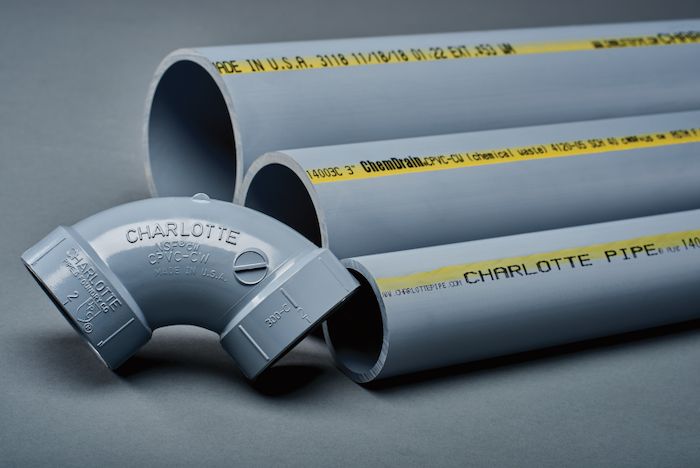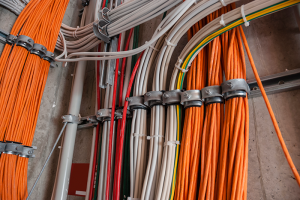Chemically compatible plumbing in health care environments

Charlotte Pipe’s ChemDrain® CPVC pipe and fittings, exhibits resistance to strong acids and alkalis but is particularly effective with oxidizers and sodium hypochlorite solutions.
Image from Charlotte Pipe and Foundry
Designing and operating a safe and reliable plumbing system for health care facilities involves many variables, including what type of waste will be traveling through the system and how to effectively manage it. This evaluation is particularly important when it comes to the chemical resistance of the selected piping materials.
As a manufacturer of both cast-iron and plastic piping systems, Charlotte Pipe and Foundry is uniquely positioned to guide health care engineers in their decision-making processes and identify the best materials for the most demanding applications.
“Chemical resistance is a broad term used to describe the ability of a material to resist degradation from chemical exposure or attack,” says Brian Helms, training manager at Charlotte Pipe and Foundry. “In the holy trinity of piping design criteria — pressure, temperature and chemical resistance — chemical resistance is often the last consideration. In health care settings, however, the chemical resistance of thermoplastic piping materials may indeed be the most important factor.”
Engineers can make informed decisions regarding material selection and system design by doing two things:
- Conducting a thorough evaluation of the chemical composition of substances to be conveyed.
- Knowing of and adhering to health care facility parameters.
How do chemicals attack piping systems?
When specifying a chemical waste drainage system for a health care setting such as a laboratory, understanding the compatibility between the system itself and the chemicals to be used and disposed of is paramount. Incompatible chemicals can attack both the inside and outside of the piping system. These chemicals infiltrate polymer chains, breaking down weaker bonds on the polymer chains and even breaking the molecular chains altogether.
Some of the effects of chemical attacks on plastic piping systems include cracking, swelling, splitting and embrittlement.
“Depending on the chemical, type of exposure, environmental conditions and the stress a system is under, the time to system failure may vary,” Helms says. “Ultimately, the result of exposing a plastic piping system to incompatible chemicals is the same: system failure.”
Plumbing system design considerations
The chemical resistance of piping materials influences design considerations for a variety of health care facility applications, including industrial pressure, continuous drainage and laboratory drainage applications.
For complex laboratory drainage piping systems, versatility is required as the system must be able to withstand a broad range of chemicals.
Laboratory drainage systems are used in many different commercial buildings, each with unique requirements that impact the system’s design. Hospital, pharmaceutical and microbiological laboratories will have different demands than settings such as schools, from K–12 to university chemistry labs. Even though dilution is typically present, these systems are exposed to various chemicals.
“Chemical resistance is probably the single most important factor for engineers in choosing a piping system in laboratory applications, but it’s not the only one,” Helms says. “Mixing chemicals can also produce a chemical reaction that releases energy in the form of heat. Therefore, in addition to chemical resistance, design professionals must also consider the temperature capabilities of any system they specify.”
Navigating chemically compatible material selection
Engineers select piping systems based on several considerations, with previous experience often leading the decision-making process. The overall installed cost and ease of maintenance for the building owner can also factor into an engineer’s decision to specify a certain piping material. Specific application parameters, however, remain at the top of the list of material selection considerations.
Unfortunately, no piping system is chemically immune to degradation from every chemical or substance ever made, as each piping material has strengths and weaknesses. In addition to proper installation, specifying the material best suited for the application parameters is key for the longevity and performance of a plumbing system.
Characteristics of thermoplastic chemical waste piping materials include:
- Polypropylene. This material is commonly used in chemical waste and even domestic water applications. This is due to its chemical resistance against weak to moderately strong acids, bases and water-soluble solvents. However, polypropylene can degrade with long-term exposure to oxidizing chemicals such as hydrogen peroxide or sodium hypochlorite.
- Polyvinylidene fluoride. This material exhibits a significant level of chemical resistance to strong acids, weaker bases, solvents and even oxidizers, but has limited resistance to some concentrated alkalis.
- Chlorinated Polyvinyl Chloride (CPVC). This material is best known by engineers as a hot and cold domestic water pipe and even a fire protection pipe. However, due to the material’s broad-based chemical resistance, industrial pressure or chemical process applications can be an ideal use of CPVC pipe in the United States.
In general, CPVC, such as Charlotte Pipe’s ChemDrain® CPVC pipe and fittings, exhibits resistance to strong acids and alkalis but is particularly effective with oxidizers and sodium hypochlorite solutions. (Of note, while CPVC is resistant to some dilute water-soluble solvents, it has limited resistance to certain strong, concentrated solvents.)
2024 plumbing code updates for chemical waste drainage
Published every three years by the International Code Council, the International Plumbing Code (IPC) provides guidance and code regulations that help ensure the engineering of safe, resilient plumbing systems. An important update included in the 2024 IPC more clearly defines what materials are approved for chemical waste drainage.
Prior to the 2024 code update, a chemical waste system was ambiguously defined as any “approved material that is resistant to corrosion and degradation for the concentration of chemicals involved.” The use of “approved material” within the definition, however, left what materials were allowable for chemical waste drainage open to interpretation.
In an effort to clarify plumbing system selection for projects such as hospitals and laboratories, a proposal was made during the 2021 code development cycle to introduce a table consisting of all materials manufactured to standards specifically for chemical waste drainage applications.
Chapter 7 of the 2024 IPC for sanitary drainage defines the requirements for a chemical waste system, detailing rules for drainage system separation, how to treat chemical waste before discharging it and allowable materials for pipe and fittings used for chemical drainage systems. In Table 702.6, Chemical Waste Drainage System and Pipe Fittings, the IPC defines approved materials and the applicable manufacturing standards.
Charlotte Pipe’s ChemDrain CPVC plumbing system
While the definition of “approved materials” for chemical waste drainage has been clarified in the 2024 IPC, Charlotte Pipe’s commitment to providing the proper materials for chemical waste drainage remains the same.
Charlotte Pipe ChemDrain CPVC pipe and fittings are manufactured with a Corzan® CPVC compound and are specifically engineered to deliver an extended lifespan of reliable, problem-free chemical waste drainage service for health care laboratories.
Manufactured to ASTM F2618, Standard Specification for Chlorinated Poly (Vinyl Chloride) (CPVC) Pipe and Fittings for Chemical Waste Drainage Systems, ChemDrain pipe and fittings are trusted and widely used by some of the nation’s top research labs thanks to the piping material’s exceptional resistance to strong acids and alkalis. Advantages of choosing ChemDrain with Corzan CPVC include:
- One-step joining method lowers labor costs and provides easy installation.
- High-temperature resistance reduces the need for system maintenance, replacement and repairs.
- Broad chemical resistance reinforces the resilience of the entire system’s infrastructure over time.
“Traditional materials — such as borosilicate glass (Kimax®) and high silicon iron (Duriron®) — are still specified in some high-end laboratories, but are becoming increasingly obsolete as cost and/or availability edges them out of the market,” says Greg Nahrgang, vice president, technical services and product development at Charlotte Pipe and Foundry. “While all of these materials have their pros and cons, Corzan CPVC is the only CPVC material delivering market-leading quality, reliability and performance for the most demanding applications.”
For more information, learn why Charlotte Pipe’s ChemDrain CPVC is the cost-effective choice for chemical waste disposal.
Charlotte Pipe and Foundry is a leading manufacturer of high-quality pipe and fittings in the United States.




